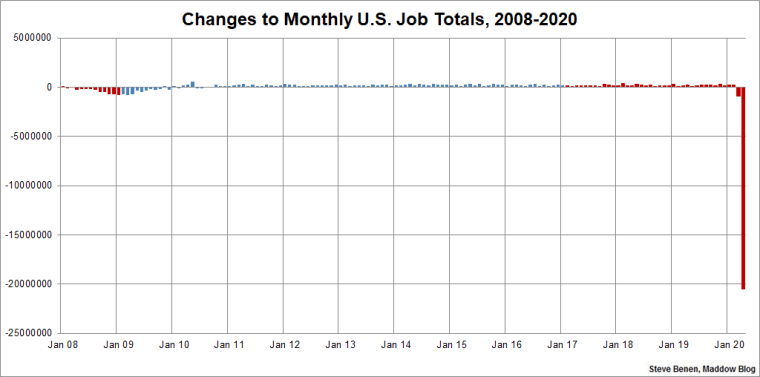
The worst single month for American job losses since the Great Depression was in September 1945, when the nation lost 2 million jobs in a single month. It was not, however, because of a sharp economic downturn; it was because World War II had just ended and the economy was starting to shift from a war-time footing to peace.
Far more recently, in March 2009, the economy lost 800,000 jobs in a single month, as the Great Recession took its toll. At the time, it seemed difficult to imagine a more severe jobs crisis.
I mention these historical notes to help provide some context for the adjective-defying job losses reported by the Bureau of Labor Statistics this morning.
Total nonfarm payroll employment fell by 20.5 million in April, and the unemployment rate rose to 14.7 percent, the U.S. Bureau of Labor Statistics reported today. The changes in these measures reflect the effects of the coronavirus (COVID-19) pandemic and efforts to contain it.
As the Great Recession started to ease in 2010, and the economy started adding jobs again, Americans saw a rather extraordinary streak. From October 2010 to February 2020 -- a 113-month period -- the U.S. economy added jobs every single month. In fact, over that period, 22.1 million jobs were created during the longest such streak on record.
Nearly all of those gains have been wiped out with extraordinary speed.
As for the unemployment rate, the government started keeping track of monthly rate fluctuations in 1948, and since that time, there have been two brutal spikes: in November 1982, unemployment reached 10.8%, and in October 2009 it reached 10%. The new rate stands at 14.7% -- and even that figure doesn't fully capture the state of the job landscape, it part because it doesn't include the under-employed or Americans who've given up looking.
Folks who've been reading me for a long time know that I started publishing monthly job charts over a decade ago, but I never thought I'd see an image like the one featured above.